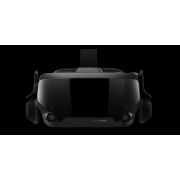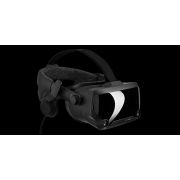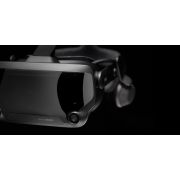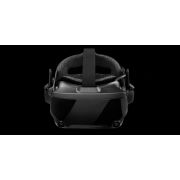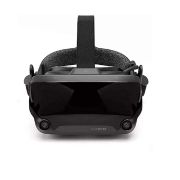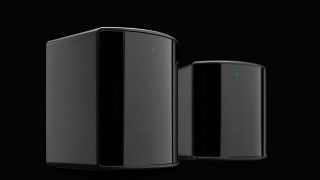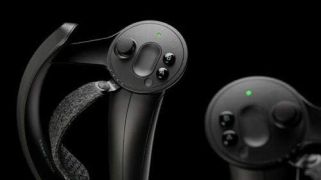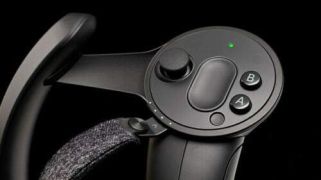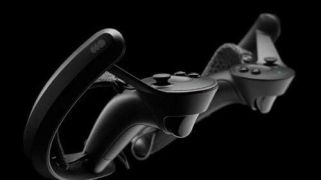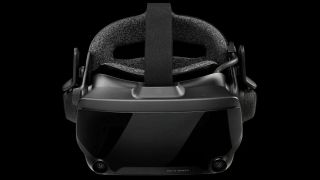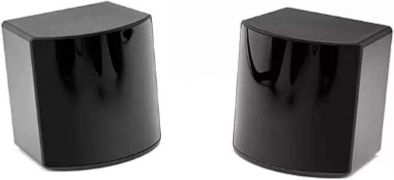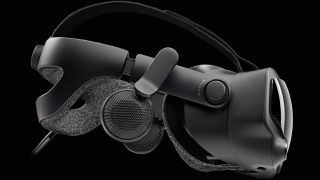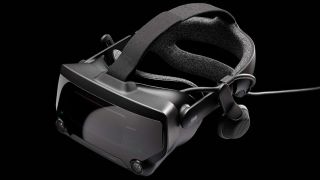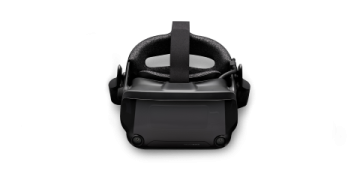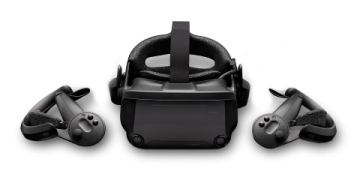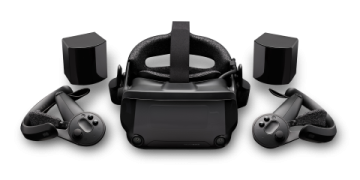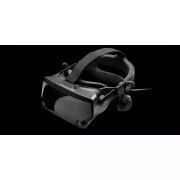Valve Index
| Valve Index | |
|---|---|
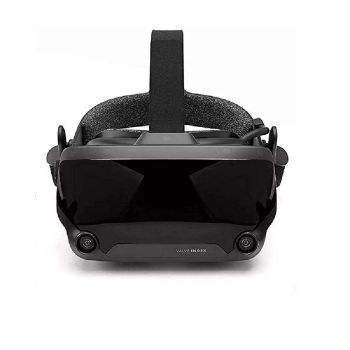
| |
| Basic Info | |
| VR/AR | Virtual Reality |
| Type | Head-mounted display |
| Subtype | PC-Powered VR |
| Platform | SteamVR |
| Creator | Valve |
| Developer | Valve |
| Manufacturer | Valve |
| Announcement Date | April 30, 2019 |
| Release Date | June 28, 2019 |
| Price | $999 (Full Kit), $749 (Headset + Controllers), $499 (Headset only), $279 (Controllers only), $149 (Base Station only) |
| Website | https://www.valvesoftware.com/en/index |
| Versions | Valve Index (2019) |
| Requires | Windows 10, SteamOS, or Linux; NVIDIA GeForce GTX 970 / AMD RX 480 or better |
| Predecessor | HTC Vive |
| System | |
| Operating System | Windows 10, SteamOS, Linux |
| CPU | Dual Core with hyperthreading, or better |
| GPU | NVIDIA GeForce GTX 970, AMD RX480, or better |
| Storage | |
| Memory | 8 GB+ |
| SD Card Slot | No |
| Display | |
| Display | Dual 1440×1600 RGB LCD panels |
| Subpixel Layout | Full RGB |
| Resolution | 2880×1600 (combined) |
| Refresh Rate | 80/90/120/144Hz |
| Persistence | 0.330ms to 0.530ms (varies with refresh rate) |
| Image | |
| Field of View | ~130 degrees (diagonal) |
| Horizontal FoV | ~108 degrees |
| Foveated Rendering | No |
| Optics | |
| Optics | Double element, canted Fresnel lens design |
| IPD Range | 58mm - 70mm (physical adjustment) |
| Adjustable Diopter | No |
| Passthrough | Stereo pass-through via front cameras |
| Tracking | |
| Tracking | SteamVR Tracking, (Lighthouse 2.0) |
| Tracking Frequency | 100Hz laser sweep |
| Base Stations | Up to 4 supported |
| Eye Tracking | No |
| Face Tracking | No |
| Hand Tracking | Via controllers (finger tracking) |
| Body Tracking | No (compatible with third-party trackers) |
| Rotational Tracking | 6 DOF |
| Positional Tracking | 6 DOF |
| Tracking Volume | Up to 10m × 10m with 4 base stations |
| Play Space | Up to 10m × 10m |
| Audio | |
| Audio | Built-in: 37.5mm off-ear Balanced Mode Radiators (BMR) |
| Microphone | Dual Microphone Array |
| 3.5mm Audio Jack | Yes |
| Camera | Stereo 960 × 960 pixel, global shutter, RGB (Bayer) |
| Connectivity | |
| Connectivity | USB 3.0, DisplayPort 1.2 |
| Ports | USB-C (expansion/accessory port) |
| Wired Video | DisplayPort 1.2 |
| Wireless Video | No |
| WiFi | No |
| Bluetooth | No |
| Power | 12V DC |
| Battery Capacity | N/A (wired) |
| Battery Life | N/A (wired) |
| Charge Time | N/A (wired) |
| Device | |
| Weight | 809g (1.78 lbs) |
| Headstrap | Adjustable rigid headstrap with rear adjustment dial |
| Haptics | Via controllers |
| Color | Black |
| Sensors | Accelerometer, Gyroscope |
| Input | Valve Index Controllers (included) |
| Cable Length | 5m (16.4 ft) |
The Valve Index is an HMD offered by Valve Corporation, the company behind the popular gaming platform Steam. Released in 2019, the Index represents Valve's entry into the high-end virtual reality hardware market with their own branded headset, building upon their previous collaboration with HTC on the HTC Vive. The full kit comes with a headset, two controllers, and two base stations. The headset requires a connection to a PC, and features high-resolution displays, innovative off-ear audio solution, and a wide field of view. The controllers, originally known as "Knuckles" during development, enable individual finger tracking through capacitive sensors and force detection. The base stations utilize the Lighthouse tracking system, an enhancement to the system previously used by the HTC Vive.[1][2]
Overview
The Valve Index is a high-end virtual reality system developed and manufactured entirely by Valve Corporation. It was designed with fidelity as a priority, focusing on delivering superior visual quality, comfort, and intuitive interaction. The system consists of three main components that can be purchased separately or as a complete kit: the headset, the controllers, and the base stations.[1]
Key Features
- High-resolution dual 1440×1600 LCD displays with full RGB subpixel array
- Up to 144Hz refresh rate, providing smooth motion
- Wide ~130° field of view
- Physical IPD adjustment (58-70mm range)
- Innovative off-ear audio solution with BMR drivers
- Advanced controllers with finger tracking and pressure sensitivity
- Front expansion port ("Frunk") with USB 3.0 for modders and developers
- Stereo RGB cameras for computer vision and mixed reality applications
- Compatible with SteamVR 2.0 and 1.0 base stations[1][3]
Release and Pricing
The Valve Index was officially announced on April 30, 2019, and began shipping on June 28, 2019. The system's launch came shortly after the releases of the Oculus Quest and Oculus Rift S.[4]
The Index was positioned as a premium VR solution, with pricing options as follows:
| Package | Price |
|---|---|
| Complete Kit (Headset, Controllers, Base Stations) | $999 |
| Headset + Controllers | $749 |
| Headset Only | $499 |
| Controllers Only (Pair) | $279 |
| Base Station (Each) | $149 |
The Valve Index is available for purchase through Steam and can be shipped to the United States, Canada, and countries within the European Union.[5]
In 2020, with the announcement and subsequent release of Half-Life: Alyx, Valve's flagship VR game, demand for the Index surged dramatically. The game was included free with all Index hardware purchases. By January 2020, the Index was sold out in all 31 available countries except Japan.[3]
Hardware
Headset
The Valve Index headset features dual 1440×1600 LCD displays, providing a combined resolution of 2880×1600 pixels. Unlike many other VR headsets that use OLED displays, the Index utilizes LCD panels with a full RGB subpixel array, which reduces the "screen door effect" commonly seen in VR. The displays support variable refresh rates of 80Hz, 90Hz, 120Hz, and an experimental 144Hz mode, with extremely low persistence (0.330ms at 144Hz) to reduce motion blur.[3]
The headset's optics consist of a custom double-element design with canted (angled) Fresnel lenses. This configuration maximizes the field of view while maintaining edge-to-edge clarity. The Index offers approximately 108° horizontal field of view, which is wider than most competing headsets.[3][6]
For user comfort, the Index includes a physical interpupillary distance (IPD) adjustment mechanism with a range of 58-70mm, accommodating a wide variety of users. The adjustment is performed via a slider located beneath the displays.
The headset's facial interface features premium antimicrobial microfiber cushioning attached via magnets for easy replacement. Valve has published specifications for the face gasket, enabling third-party manufacturers to develop aftermarket solutions.[6]
One of the Index's standout features is its audio solution. The headset includes "off-ear" speakers that don't touch the user's ears, using 37.5mm Balanced Mode Radiator (BMR) drivers. This design provides a more natural audio experience while keeping ears cool during extended play sessions. The headset also includes a 3.5mm audio jack for users who prefer their own audio solution, as well as a dual microphone array for voice communication.[6]
The front of the headset houses dual RGB cameras (960×960 pixels each) with global shutter sensors. These cameras enable developers to create computer vision applications and provide users with a high-quality stereo pass-through view of their surroundings.[6]
For tinkerers and developers, the Index includes a front compartment dubbed the "Frunk," which houses a USB 3.0 Type-A port specifically designed for experimental attachments and modifications.[6]
Controllers
The Valve Index Controllers, previously known during development as "Knuckles," represent a significant advancement in VR input devices. Unlike traditional VR controllers that must be gripped continuously, the Index Controllers are secured to the user's hands with adjustable straps, allowing users to completely release their grip without dropping the controllers.[7]
Each controller features 87 sensors that work together to track hand position, finger position, motion, and pressure. These sensors enable individual finger tracking, allowing for natural gestures and interactions in VR. The controllers continuously recalibrate to adapt to different hand sizes and changing skin capacitance.[7]
The Index Controllers include a variety of traditional input methods:
- Analog thumbstick
- Trackpad with force sensor
- Two face buttons (A/B)
- System button
- Trigger with force sensor
- Grip force sensor
- Finger tracking sensors[7]
The controllers are powered by internal rechargeable batteries with a usage time of approximately 7 hours, and can be charged via USB-C connectors. They feature capacitive grip and button sensors, enabling the system to detect which fingers are touching the controller and which are raised, providing a more intuitive way to interact with virtual objects.[7]
A 2018 tech demo titled "Moondust" was released to showcase the capabilities of an early version of the Knuckles controllers, demonstrating the precise finger tracking and pressure sensitivity.[3]
| Feature | Specification |
|---|---|
| Input Methods | Thumbstick, Trackpad, A/B Buttons, System Button, Trigger, Grip |
| Sensors | 87 sensors per controller for position, motion, and pressure |
| Tracking | 6 DOF via Lighthouse system |
| Battery | 7+ hours per charge (rechargeable) |
| Charging | USB-C |
| Haptics | HD haptics |
| Strap | Adjustable at three points, antimicrobial fabric |
| Weight | Approximately 198g per controller |
Base Stations
The Valve Index utilizes Valve's Lighthouse 2.0 tracking system, which provides high-precision, sub-millimeter position tracking. The system uses external base stations that emit invisible infrared laser patterns to track the headset and controllers.[8]
The Lighthouse 2.0 base stations improve upon the previous generation with:
- Wider 150° field of view
- Improved range
- Support for up to four base stations in a single setup (vs. two in the original system)
- Simplified design (single rotor vs. dual rotor in 1.0)
- No sync cable requirement between base stations[8][9]
Each base station sweeps infrared laser beams across the play area 100 times per second, which are detected by photosensors on the headset and controllers. This allows the system to precisely track the position and orientation of all devices in 3D space.[8]
The tracking system can support a play area of up to 10m × 10m (approximately 33ft × 33ft) when using four base stations. For optimal tracking performance, base stations should be mounted above head height and positioned to maximize visibility of the tracked devices.[10]
Valve Index Base Stations are compatible with other SteamVR 2.0 tracking devices, including the HTC Vive Pro. Additionally, the Index headset and controllers are backward compatible with the original Lighthouse 1.0 base stations used by the original HTC Vive.[8]
System Requirements
To use the Valve Index, a PC meeting the following minimum specifications is required:
| Component | Minimum | Recommended |
|---|---|---|
| Operating System | Windows 10, SteamOS, Linux | Windows 10, SteamOS, Linux |
| Processor | Dual Core with Hyperthreading | Quad Core+ |
| Memory | 8 GB RAM | 8 GB+ RAM |
| Graphics | NVIDIA GeForce GTX 970 / AMD RX 480 | NVIDIA GeForce GTX 1070 or better |
| Ports | DisplayPort 1.2, USB 3.0 | DisplayPort 1.2, USB 3.0 |
| Additional | Additional USB port required for camera passthrough | - |
To achieve the maximum 10m × 10m play space, four base stations are required. Users can also use the base stations that come with the HTC Vive instead of purchasing additional Valve Index base stations, although this would limit the play space to the capabilities of the Lighthouse 1.0 system.[11]
Setup
Unlike standalone HMDs like the Oculus Quest, the Valve Index requires proper setup of base stations to track the user's movements. The setup process involves:
1. Mounting the base stations in opposite corners of the play area, ideally above head height (at least 2m/6.5ft). 2. Adjusting the base stations to point toward the center of the play area. 3. Connecting the headset to the PC via DisplayPort and USB. 4. Running the SteamVR setup process to define the play area boundaries. 5. Pairing and calibrating the controllers.[10]
For optimal tracking performance, the base stations should be positioned to maximize visibility of the headset and controllers during use. Reflective surfaces in the play area may interfere with tracking and should be covered if possible.[11]
Input Devices
The primary input devices for the Valve Index are the Index Controllers, which come with the full kit. These controllers feature individual finger tracking, pressure sensitivity, and traditional inputs like joysticks, buttons, and triggers.
The Index is also compatible with the controllers from the HTC Vive and HTC Vive Pro, providing flexibility for users upgrading from these systems or those who prefer the traditional controller design for certain applications.[3]
For more specialized input, the Index is compatible with a variety of third-party SteamVR tracking devices, including:
- Vive Trackers for full-body tracking
- Third-party driving and flight simulator controls
- Specialized controller accessories[1]
Accessories
The Valve Index supports various accessories to enhance the VR experience:
- Replacement Face Gaskets - Valve sells replacement facial interfaces with cushions in 2-packs ($39.99).
- VR Covers - Third-party facial interface covers and replacements for improved comfort and hygiene.
- Prescription Lens Adapters - For users who wear glasses.
- Cable Management Solutions - Overhead pulley systems to manage the headset's cable.
- Controller Grips - Additional grips and protective covers for the controllers.
- Frunk Accessories - USB devices that connect to the front expansion port.
- Storage Cases - Travel and storage cases for the complete system.[12]
Software
The Valve Index operates using SteamVR, Valve's virtual reality platform. Users can purchase games and applications through the Steam store, which offers a vast library of VR content.
The Index is also compatible with content from Viveport, HTC's VR content platform, providing additional options for applications and games.[1]
Valve's Half-Life: Alyx was developed specifically with the Index in mind and is included free with the purchase of Index hardware. This critically acclaimed game showcases the capabilities of the Index controllers, with fine-grained interactions made possible by the finger tracking technology.[3]
Developer Support
Developers interested in creating content for the Valve Index can access resources through the Valve Developer Community. Valve provides documentation and examples for utilizing the unique features of the Index, including:
- SteamVR Input System for controller integration
- Finger tracking implementation guidelines
- High refresh rate optimization techniques
- Audio design considerations for the off-ear speakers
A dedicated Input Binding UI within SteamVR allows users to customize controller mappings for games and applications that don't natively support the Index Controllers.[1]
Performance and Reviews
The Valve Index has been widely praised for its high-quality displays, comfortable design, and innovative controllers. Critics have noted several standout features:
- The high refresh rate (especially at 120Hz and 144Hz) provides exceptionally smooth motion.
- The wider field of view offers a more immersive experience than most competing headsets.
- The off-ear speakers provide excellent audio quality while maintaining awareness of the surroundings.
- The finger tracking controllers enable more natural interactions in supported applications.[2]
Some reviewers have pointed out limitations:
- The high price makes it less accessible than more mainstream options.
- The wired connection limits mobility compared to standalone headsets.
- The external base stations require more setup than inside-out tracking solutions.
- The full resolution and refresh rate capabilities demand a powerful PC.[12]
Despite these limitations, the Index is generally considered one of the premium VR experiences available for PC users, particularly for those who prioritize visual fidelity and tracking precision.[2]
Images
Future Developments
In February 2021, Valve registered patents for a new VR headset, indicating ongoing development in the VR hardware space. These patents described various improvements over the current Valve Index design, suggesting that Valve continues to invest in VR technology advancement.[3]
History
- February 2017: First prototypes of "Knuckles" controllers demonstrated.
- June 2018: "Moondust" tech demo released to showcase controller capabilities.
- March 2019: Images and preliminary information leaked via Valve's website.
- April 30, 2019: Valve Index officially unveiled with full specifications.
- May 1, 2019: Pre-orders opened for the Index.
- June 28, 2019: First shipments began to customers.
- November 2019: Half-Life: Alyx announced, included free with Index hardware.
- March 2020: Half-Life: Alyx released, driving increased demand for the Index.
- January 2020: Index sold out in most regions due to high demand.
- February 2021: Valve files patents for new VR headset design.[3][13]
Images
References
- ↑ 1.0 1.1 1.2 1.3 1.4 1.5 https://www.valvesoftware.com/en/index
- ↑ 2.0 2.1 2.2 https://www.theverge.com/2019/6/28/19102584/valve-index-steamvr-headset-review-shipping-today
- ↑ 3.0 3.1 3.2 3.3 3.4 3.5 3.6 3.7 3.8 https://en.wikipedia.org/wiki/Valve_Index
- ↑ https://www.theverge.com/2019/4/30/18524167/valve-index-vr-headset-price-pre-order-date
- ↑ https://help.steampowered.com/en/faqs/view/339C-BC5C-3D89-53D9
- ↑ 6.0 6.1 6.2 6.3 6.4 https://www.valvesoftware.com/en/index/headset
- ↑ 7.0 7.1 7.2 7.3 https://www.valvesoftware.com/en/index/controllers
- ↑ 8.0 8.1 8.2 8.3 https://www.valvesoftware.com/en/index/base-stations
- ↑ https://mixed-news.com/en/valves-lighthouse-tracking-system-how-it-started-where-its-going/
- ↑ 10.0 10.1 https://steamcommunity.com/sharedfiles/filedetails/?id=2985037346
- ↑ 11.0 11.1 https://www.vive.com/us/support/vive-pro/category_howto/tips-for-setting-up-the-base-stations.html
- ↑ 12.0 12.1 https://www.tomshardware.com/reviews/valve-index-vr-headset-controllers,6205.html
- ↑ https://www.inverse.com/article/54708-valve-index-vr-headset-release-date-price-specs-steam


